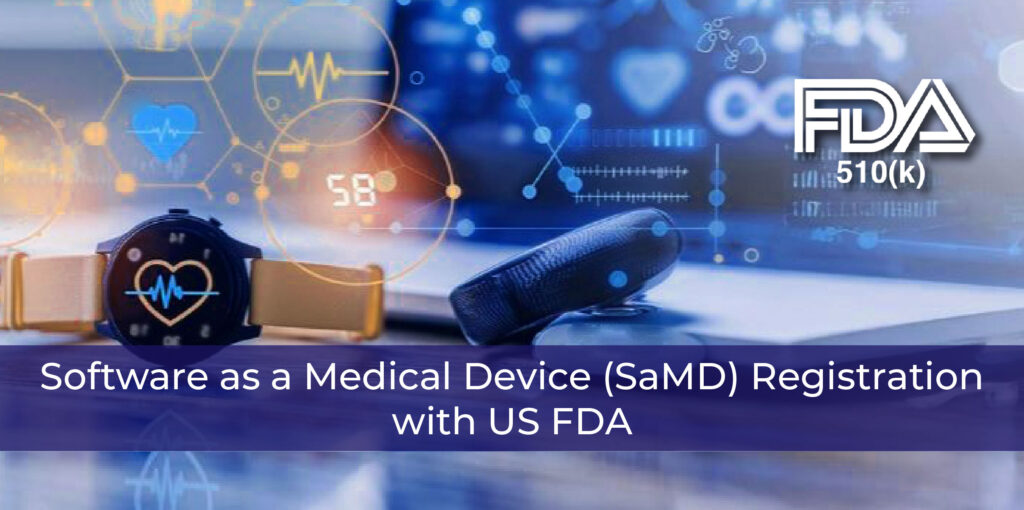SaMD Registration with US FDA
Accelerate Your Software as a Medical Device Approval with US FDA
SaMD Registration with US FDA is a critical regulatory requirement for companies developing software intended for medical purposes that operates independently of hardware medical devices.
As digital health, AI-driven diagnostics, and clinical decision-support software rapidly evolve, ensuring FDA compliance is essential to demonstrate safety, effectiveness, and readiness for the U.S. healthcare market.
The U.S. Food and Drug Administration (US FDA) regulates Software as a Medical Device (SaMD) under its medical device framework.
Before commercialization, manufacturers must meet defined regulatory, quality, clinical, and cybersecurity requirements based on the software’s intended use and risk classification.
Looking for SaMD Registration with US FDA?
Let’s have a words about your project
Why US FDA Registration for SaMD is Essential
US FDA registration is a critical step for SaMD manufacturers to
- Ensure compliance with regulatory requirements for safety and effectiveness.
- Gain access to the U.S. healthcare market.
- Establish credibility and trust with healthcare providers and patients.
- Mitigate risks of regulatory penalties and market withdrawals.

US FDA Regulatory Pathway for SaMD
The US FDA classifies SaMD based on its intended use and level of risk, following a tiered regulatory framework. Key steps in the FDA registration process include:
- Device Classification & Risk Assessment
- SaMD is categorized as Class I, II, or III based on its impact on patient safety.
- The risk level determines the type of regulatory submission required.
- Premarket Submissions
- 510(k) Clearance: Required for moderate-risk devices proving substantial equivalence to an existing device.
- De Novo Classification: Applicable for novel SaMD solutions without a direct predicate device.
- Premarket Approval (PMA): Mandatory for high-risk devices requiring clinical evidence of safety and effectiveness.
- Quality Management System (QMS) Compliance
- SaMD manufacturers must comply with 21 CFR Part 820 (Quality System Regulation) and adopt an effective Software Development Life Cycle (SDLC).
- Clinical Evaluation and Cybersecurity Considerations
- Clinical validation of software performance is only essential for high-risk devices.
- Robust cybersecurity measures must be integrated to protect patient data and ensure software integrity.
- Post-Market Surveillance & Compliance
- To maintain compliance, continuous monitoring, adverse event reporting, and software updates are necessary.
Global SaMD Standard Recognized by the US FDA
The U.S. FDA recognizes several international standards for Software as a Medical Device (SaMD) to ensure safety, effectiveness, and regulatory compliance. Some key standards include:
Which Risk Class of SaMD Requires a 510(k)?
Determining the risk classification of your Software as a Medical Device (SaMD) is a crucial step in the U.S. market registration process. SaMD is categorized into different classes based on risk levels. Class II SaMD, considered moderate risk, typically requires a 510(k) clearance. This process involves demonstrating substantial equivalence to a legally marketed predicate device, ensuring the software meets safety and efficacy standards before commercialization.
How Long is the Clearance Valid?
US FDA 510(k) clearance remains valid unless there are significant modifications to the device or changes in applicable regulations. However, the U.S. FDA may require periodic reports or additional information to ensure ongoing compliance and safety.
Get Expert Guidance for FDA SaMD Registration
Navigating the FDA regulatory landscape for SaMD can be complex. Partner with Operon Strategist for expert guidance and hassle-free compliance. Contact us today to accelerate your FDA registration process!
Role of Operon Strategist in SaMD US FDA Registration
As a leading medical device regulatory consulting company, Operon Strategist provides comprehensive support for SaMD Registration with US FDA. Our expertise includes:
Regulatory Strategy & Gap Analysis: Identifying applicable regulatory requirements and ensuring compliance with US FDA guidelines for SaMD Registration with US FDA.
Device Classification & Submission Preparation: Assisting in selecting the correct FDA submission pathway (510(k), De Novo, or PMA) and preparing required documentation for SaMD Registration with US FDA.
Quality System Implementation: Supporting manufacturers in establishing and maintaining FDA-compliant QMS in line with SaMD Registration with US FDA requirements.
Clinical & Cybersecurity Compliance: Providing guidance on clinical validation and cybersecurity controls to support safe and compliant SaMD Registration with US FDA.
Post-Market Regulatory Support: Assisting with post-market surveillance, reporting, and software updates to ensure ongoing compliance after SaMD Registration with US FDA.
With extensive experience in regulatory consulting, Operon Strategist ensures a smooth and efficient SaMD Registration with US FDA, helping manufacturers bring compliant and innovative medical software solutions to the U.S. market with confidence.
FAQs
What is Software as a Medical Device (SaMD)?
SaMD refers to software intended for medical purposes that can function independently of any physical medical device. Examples include diagnostic imaging software, mobile apps for chronic disease management, and AI-based decision support tools.
Is FDA registration mandatory for SaMD?
Yes. All SaMD intended for use in the U.S. must be registered with the FDA. The type of regulatory submission—510(k), De Novo, or PMA—depends on the software's risk classification and intended use.
How long does FDA approval for SaMD take?
The timeline depends on the type of submission. A 510(k) clearance may take 3–6 months, De Novo submissions around 6–9 months, and PMA approvals can take over a year depending on clinical data requirements.
Do I need clinical trials for SaMD approval?
It depends on the classification and intended use. Class III and some Class II SaMD products may require clinical evidence to demonstrate safety and effectiveness.
